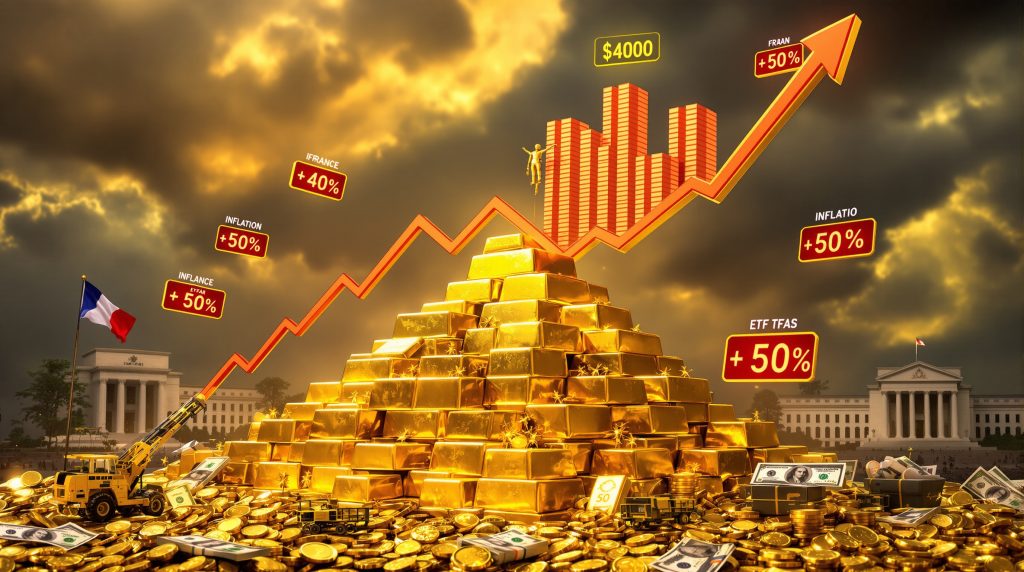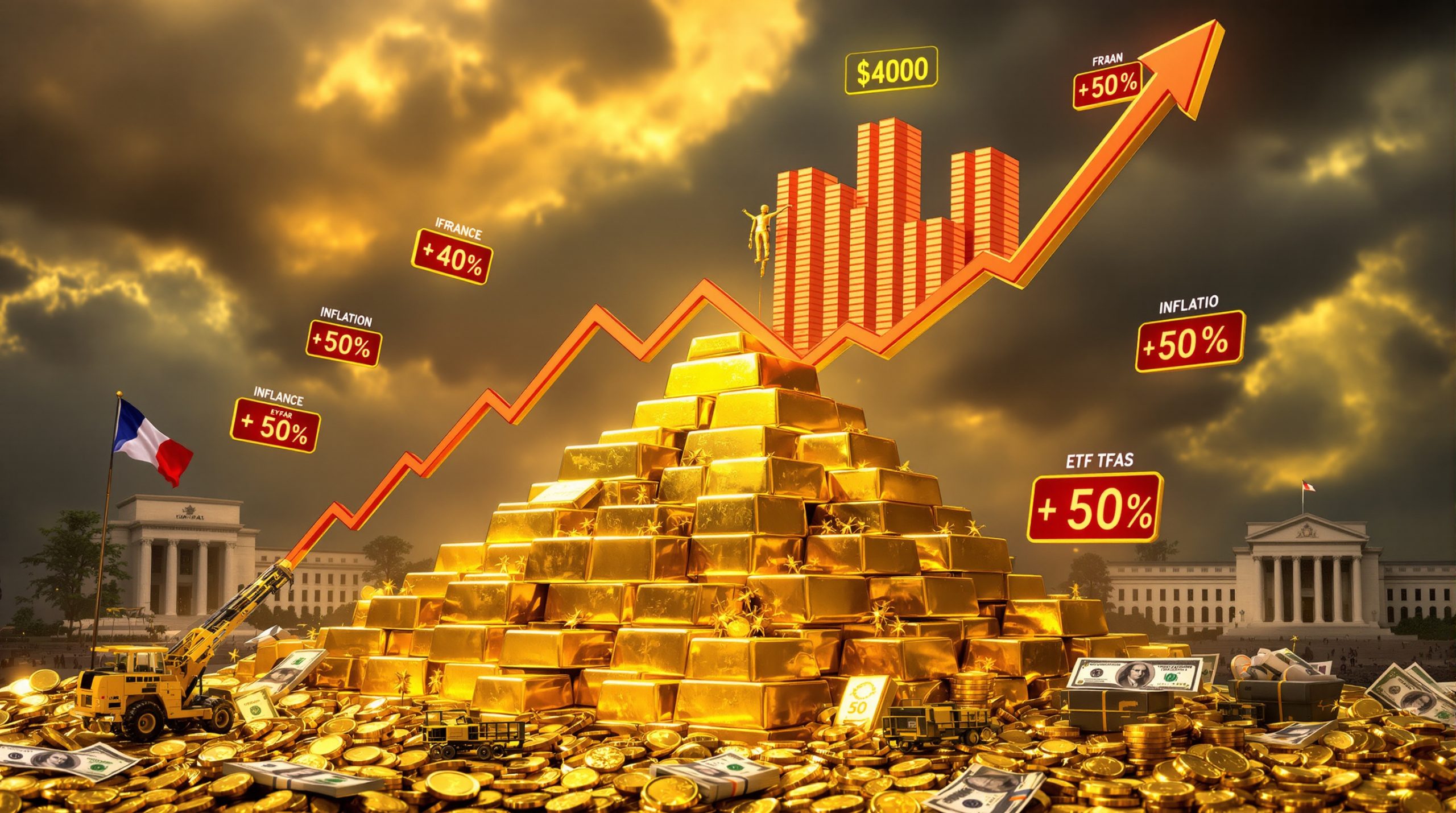Why Has Gold Reached This Unprecedented Milestone?
Gold's ascent past the $4,000 per ounce mark represents one of the most remarkable developments in modern financial markets. October 2025 has witnessed this precious metal trading at an astonishing $4,058, completing a journey that few analysts predicted even at the beginning of the year. This 50% year-to-date surge reflects a complex interplay of monetary policy, geopolitical tensions, and fundamental investor psychology.
Multiple Economic Forces Driving the Rally
The Federal Reserve's monetary policy has created an exceptionally favorable environment for gold. Following September 2025's rate cut and strong indications of continued easing, the opportunity cost of holding non-yielding assets like gold has significantly decreased. This policy shift comes amid persistent inflationary pressures that have proven more stubborn than initially expected by monetary authorities.
Global economic uncertainty has intensified throughout 2025, pushing traditionally conservative investors toward safe‐haven investment insights. Institutional allocations to precious metals have increased substantially, creating additional price pressure in a market already experiencing supply constraints. Mining output has struggled to match the surging demand, creating a supply-demand imbalance that continues to support higher prices.
Key factors supporting the price surge include:
- Persistently high inflation despite central bank interventions
- Reduced opportunity costs from lower interest rates
- Supply chain disruptions affecting mining operations
- Increased institutional allocation to precious metals
Geopolitical Tensions Creating Perfect Storm
The current administration's trade policies have emerged as a significant driver of gold's rally. Market participants increasingly view gold as insurance against potential economic disruption from escalating tariffs and trade disputes. The dollar's strength following political developments in France and Japan has paradoxically failed to dampen gold's momentum, highlighting the unusual nature of this rally.
Central banks worldwide have accelerated gold purchases as a hedging strategy against potential sanctions, creating additional demand pressure. This sanctions-related buying represents a fundamental shift in reserve management philosophy among many emerging market central banks.
The recent US government shutdown has complicated matters by limiting access to reliable economic data, forcing investors to make decisions in an information-restricted environment. This uncertainty has further fueled the flight to gold as a tangible store of value.
How Are Central Banks Influencing the Gold Market?
Central bank activity has emerged as perhaps the most significant structural change in the gold market in recent years, with monetary authorities demonstrating unprecedented appetite for the precious metal.
Strategic Reserve Building
Global monetary authorities have engaged in record-breaking gold purchases throughout 2025, fundamentally altering market dynamics. This accumulation extends beyond traditional gold-friendly central banks to include a diverse range of economies seeking to reduce dependency on traditional reserve currencies.
De-dollarization strategies have gained momentum among emerging market economies, with gold serving as a critical component of this transition. Nations from Southeast Asia to South America have publicly declared intentions to reduce dollar exposure in favor of gold and other alternatives.
Currency risk mitigation has become a primary motivation as monetary authorities seek protection from exchange rate volatility. Physical gold holdings provide a form of insurance against currency crises that can't be matched by any paper asset.
The central bank buying trend is evident across multiple regions:
- East Asian economies increasing allocations by 15-20% annually
- Middle Eastern oil producers converting energy profits to gold
- Eastern European nations rebuilding reserves after decades of minimal gold exposure
- South American central banks diversifying away from traditional dollar holdings
Monetary Policy Impact
The September 2025 rate cut implemented by the Federal Reserve marked a pivotal moment in gold's trajectory, removing one of the few remaining headwinds to higher prices. This policy shift confirmed market expectations of a more accommodative monetary environment.
Expected future easing measures have been largely priced into current gold valuations, though additional rate cuts could still provide upward momentum. The real yield environment has created particularly favorable conditions for non-yielding assets like gold, as inflation-adjusted returns on fixed-income alternatives remain unattractive.
What's Driving Retail and Institutional Investment in Gold?
Beyond central bank activity, both retail and institutional investors have significantly increased gold allocations in their portfolios, reflecting changing attitudes toward traditional investment classes.
Inflation Hedging Strategies
Consumer price persistence has confounded policy makers and eroded purchasing power, driving investors toward proven inflation hedges. Despite aggressive central bank intervention, core inflation measures remain elevated above target levels in most developed economies.
Gold's historical performance during inflationary periods continues to attract investors seeking protection against currency devaluation. Analysis of previous inflation cycles demonstrates gold's tendency to outperform most financial assets during periods of sustained price increases.
Real asset preference has emerged as a dominant investment theme, with precious metals benefiting alongside other tangible stores of value. This shift represents a fundamental reappraisal of portfolio construction principles that had previously emphasized financial assets over physical ones.
Historical data shows that during the five most significant inflationary periods since 1970, gold has delivered average real returns exceeding 15% annually while traditional fixed income investments often produced negative real returns.
ETF and Physical Demand Trends
Significant inflows into gold-backed ETFs indicate strong institutional interest, with these investment vehicles seeing record allocations. Professional money managers have increased gold positions as both a portfolio diversifier and a hedge against broader market volatility.
Physical bullion acquisition patterns among retail investors show heightened activity, with dealer networks reporting strong demand for coins and small bars. Premium developments for physical gold products have expanded, with many popular items commanding 5-8% over spot prices versus historical averages of 3-4%.
Inventory levels at major dealers and mints worldwide have reached multi-year lows, with production struggling to keep pace with demand. Wait times for certain products have extended from days to weeks, indicating robust retail participation in the gold market.
Is This Gold Rally Sustainable?
The extraordinary pace of gold's ascent naturally raises questions about sustainability, with analysts divided on the metal's near-term prospects despite agreement on positive long-term fundamentals.
Technical Analysis Perspectives
Bank of America has issued warnings about uptrend exhaustion, suggesting a correction may occur before year-end 2025. Their technical analysis indicates momentum indicators reaching levels historically associated with temporary price retracements.
Price resistance levels beyond the $4,000 threshold remain largely theoretical, as the market explores previously uncharted territory. Historical comparisons with previous bull markets suggest that while corrections are common, they typically prove temporary within established uptrends.
Technical indicators currently flashing caution signs include:
- Relative Strength Index readings above 75 on multiple timeframes
- Declining volume on recent price advances
- Expanding futures open interest suggesting speculative positioning
- Widening gap between spot prices and longer-term moving averages
Fundamental Outlook Factors
Supply constraints in global mining operations continue to support higher prices, with few major discoveries entering production. Production cost increases, particularly in energy and labor, have raised the effective floor price needed for profitable mining.
Central bank buying projections through 2026 suggest continued strong official sector demand, providing a potential cushion against major price declines. Investment strategies and forecasts under various economic scenarios indicate sustained interest in gold exposure, though perhaps at a more measured pace than recent months.
How Does Gold's Performance Compare to Other Metals?
While gold has captured headlines with its all‐time high analysis, other metals have shown divergent performance patterns, creating a complex landscape for natural resource investors.
Copper Market Dynamics
Recent price retreat from previous rally highs has seen three-month copper on the London Metal Exchange fall 0.7% to approximately $10,600 per ton, with CME copper futures dropping about 1%. This modest pullback follows significant gains earlier in the year.
Supply disruptions at major mines have prevented more substantial price declines, with Freeport McMoRan's declaration of force majeure at its Grasberg operation in Indonesia following deadly mudslides. The Grasberg incident, affecting the world's second-largest copper producer, will remove nearly 600,000 tons of copper supply according to market analysts.
Inventory levels at major exchanges remain near multi-year lows, providing fundamental support for prices despite recent dollar strength. Industry experts note that while copper has retreated from peak levels, underlying supply-demand fundamentals remain constructive for prices.
Rare Earth Elements and Critical Minerals
Strategic importance of these materials in global technology supply chains has attracted increased investor attention. The Tan Breeze project in Greenland, considered one of the largest undeveloped rare earth resources globally, highlights the growing focus on securing these critical inputs.
Government investment considerations have become a major market factor, though recent clarifications from Washington denied reports of potential stake acquisitions in certain mining operations. Such denials caused significant volatility in affected company shares, with Critical Minerals' stock doubling before retreating after the White House statement.
Market reactions to even rumors of government involvement demonstrate the heightened sensitivity surrounding critical mineral supplies. The strategic nature of these resources continues to influence both corporate strategies and national policies.
What Are the Investment Implications of Gold's Historic Run?
The unprecedented price environment creates both opportunities and challenges for investors seeking exposure to the gold sector.
Portfolio Allocation Strategies
Optimal precious metals positioning in diversified portfolios requires careful consideration of correlation benefits and volatility characteristics. Traditional allocation models suggesting 5-10% gold exposure may require reevaluation in the current environment.
Risk management approaches using gold as a stabilizing asset have gained popularity, with the metal demonstrating its ability to perform during periods of market stress. Entry point considerations at record price levels present challenges, with dollar-cost averaging strategies potentially reducing timing risks.
Strategic allocation approaches to consider include:
- Systematic rebalancing to maintain target gold allocations
- Options strategies to establish positions at predetermined price levels
- Combination approaches using both physical holdings and paper gold instruments
- Sector rotation within precious metals, including miners, royalty companies, and physical metal
Mining Company Evaluation
Producer profitability metrics at current price levels show extraordinary margins for established miners with controlled cost structures. With gold prices above $4,000 and all-in sustaining costs for most major producers between $1,100-$1,500 per ounce, operating margins have expanded significantly.
Exploration company valuation shifts in the new price environment have attracted speculative capital, though discriminating between quality projects and promotional ventures remains challenging. M&A activity acceleration exemplified by Bareric Mining's recent transactions suggests further industry consolidation, with the company selling its Toén gold mine for up to $35 million to strengthen its balance sheet.
Production guidance adjustments from major producers will influence supply forecasts, potentially supporting continued price surge insights. Atlantic Group's entry into the "fast-growing gold sector" through acquisition illustrates the attractive economics currently available to producers.
How Might Geopolitical Developments Affect Gold's Trajectory?
Geopolitical factors have emerged as primary drivers of gold demand, with potential for continued influence on market dynamics.
Trade Policy Implications
Tariff implementation effects on global economic growth could further increase safe-haven demand for precious metals. The current administration's trade policies have already created significant market uncertainty, contributing to gold's appeal.
Currency market volatility stemming from policy uncertainty tends to favor gold as a non-sovereign store of value. History demonstrates that periods of heightened currency volatility typically coincide with strong precious metals performance.
Safe-haven demand surges during diplomatic tensions provide support for gold prices independent of traditional economic factors. Political shifts in France and Japan have already influenced currency markets and by extension precious metals sentiment.
Regional Stability Factors
Resource nationalism trends affecting mining jurisdictions have increased operational risks for producers in certain regions. Companies operating in politically stable jurisdictions command premium valuations in the current environment.
Supply chain resilience strategies increasingly incorporate precious metals as strategic reserves. Political transition risks in key mining regions continue to influence corporate decision-making and capital allocation.
Regulatory environment shifts affecting production and trade could create additional supply constraints in an already tight market. Environmental regulations in particular have extended permitting timelines and increased development costs.
What Should Investors Watch for in Q4 2025 and Beyond?
As the year progresses toward its conclusion, several key indicators will help determine whether gold's rally continues or moderates.
Key Market Indicators
Federal Reserve meeting outcomes and forward guidance will remain central to gold's performance. Any deviation from expected easing measures could trigger significant price volatility.
Inflation data releases and their market interpretation will influence investment flows toward or away from precious metals. ETF flow momentum serves as a reliable sentiment indicator, with sustained inflows supporting price appreciation.
Central bank purchase patterns from quarterly reports provide valuable insights into official sector demand trends. Any significant reduction in central bank buying could remove an important price support.
Critical market events to monitor include:
- November Federal Reserve policy meeting
- Q4 inflation reports from major economies
- Year-end institutional portfolio rebalancing
- Mining company production reports and 2026 guidance
Potential Correction Scenarios
Profit-taking trigger points after substantial gains could emerge, particularly around key psychological price levels. Technical support levels for potential consolidation phases include recent breakout points that may now function as support.
Seasonal patterns affecting precious metals markets suggest potential weakness in early Q4 followed by strength toward year-end. Correlation shifts with other asset classes during market stress could impact gold's performance during broader market corrections.
While gold's fundamentals remain strong, the rapidity of the recent advance suggests some consolidation would be normal and healthy for the longer-term trend.
FAQ: Gold's Historic Price Movement
What factors pushed gold beyond the $4,000 threshold?
The unprecedented rise reflects a perfect storm of conditions: Federal Reserve rate cuts reducing opportunity costs of holding non-yielding assets, intensifying geopolitical tensions, persistent inflation concerns, and significant central bank purchasing for reserve diversification. The metal gained considerable momentum after the Fed's September rate cut, with expectations for continued monetary easing providing additional support.
How does this rally compare to previous gold bull markets?
The current 50% year-to-date gain in 2025 represents one of the steepest annual climbs in modern history, exceeding even the notable rallies during the 2008 financial crisis and the 2020 pandemic response period. The pace of appreciation has surpassed most historical precedents, though the fundamental drivers share similarities with previous bull markets in terms of monetary policy, inflation concerns, and geopolitical tensions.
Should investors consider gold at these price levels?
While timing market tops is challenging, allocation decisions should consider portfolio diversification benefits, inflation protection needs, and individual risk tolerance rather than focusing solely on price entry points. Systematic accumulation strategies can help mitigate timing risks in volatile markets. Most portfolio managers recommend maintaining gold exposure through various price environments rather than attempting to time entry and exit points perfectly.
What could trigger a gold market correction?
Potential catalysts include unexpected shifts in Federal Reserve policy, significant easing of geopolitical tensions, substantial profit-taking by institutional investors, or dramatic strengthening of the US dollar. Bank of America analysts have specifically warned of "uptrend exhaustion" with the potential for correction before year-end 2025. Technical indicators suggesting overbought conditions could also contribute to temporary price retracements, though the long-term gold price forecast remains positive.
Ready to Spot the Next Major Mineral Discovery?
Stay ahead of the market with Discovery Alert's proprietary Discovery IQ model, delivering real-time notifications when significant mineral discoveries are announced on the ASX. Visit our discoveries page to see how early identification of major mineral finds has historically generated exceptional returns for investors.




